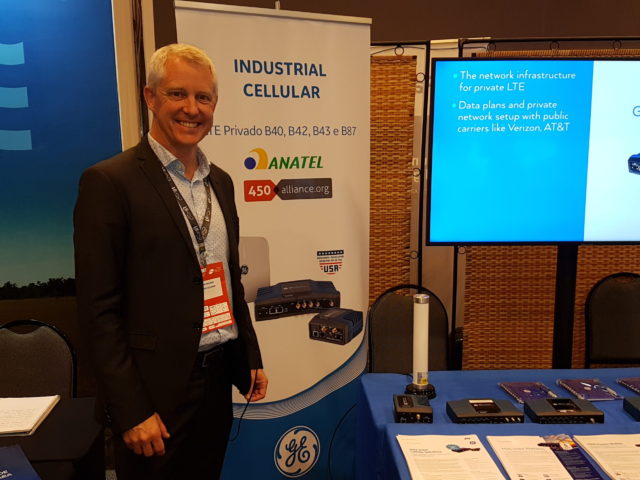The GE booth at UTCAL 2022 featuring 450 MHz Alliance logo. GE is a member of 450 MHz Alliance.
Neoenergia tests sub-giga band to expand private communication networks
The Sub-GHz 3GPP frequency band drives the expansion of the private LTE network efficienty and in a lower investment, while adding multiservice traffic
Neoenergia is investing in digitalization and innovation to improve the quality of services for its clients and to contribute to the digital transformation of the energy sector. Neoenergia, through a proof of concept (PoC), is going to assess the use hier range frequency to expand the private LTE network efficiently and at a lower cost. The fourth-generation (4G) mobile communication standard is called Long Term Evolution (LTE).
The pioneering initiative is part of the Energy of the Future project, in Atibaia, São Paulo State, which has been rolling out a new smart grid model, based on digitalization in grid automation and smart metering. The study is going to assess the 410 MHz band that is standardized in LTE in band 87 by 3GPP (a technological organization that standardizes telecommunications specifications around the world). In Brazil, the 410 -415 MHz and 420-425 MHz bands are being considered by the National Telecommunications Agency (ANATEL) within the scope of item 35 of the Regulatory Agenda and, therefore, the proof of concept to be carried out in Atibaia, State of São Paulo, in Neoenergia Elektro’s concession area, was authorized as a special service for scientific and experimental purposes.
The 410 MHz frequency band is of interest to Neoenergia because it provides a good coverage and capacity ratio. The propagation features od the band under evaluation allow for broad coverage at lower base station infrastructure costs, potentially optimizing implementation costs. As the demand for communication along power distribution networks is increasing, the 410 MHz band is seen by the organization as having great potential in the development of a multiservice LTE network that can carry mission-critical services and broadband, being able to support automation, smart metering, voice, data, and video communication applications, among other innovative services, such as augmented reality, artificial intelligence, and drone inspection, to name a few.
Low Power Wide Area (LPWA) technologies, such as Narrowband IoT (NB-IoT) and Cat-M, are also in band 87 and open up opportunities for communication with the Internet of Things (IoT) as a smart meter, automated reclosers, loss sensors, capacitor banks, and voltage regulators. Both NB-IoT and Cat-M technologies were included in the 3GPP’s release 13 and can evolve into 5G networks.
Another feature that makes the 410 MHz band attractive for Neoenergia’s advanced metering infrastructure (AMI) is the good penetration of the radio frequency signal, which allows the private LTE network to be taken directly to the customer (smart meter), without the need for other access technologies or equipment, simplifying the network architecture and contributing to better management by Neoenergia’s operation and maintenance (O&M) team.
The smart meter communication modules (Network Interface Card – NIC) developed for this proof of concept support the private and public communication frequencies of interest to Neoenergia, allowing agile deployment to serve all five distributors which are part of Neoenergia’s group, in addition to being able to operate both in regions where the company does not have a private network, through a partnership with carriers and in regions where the investment has already been made, such as Atibaia.
However, having a standardized frequency band is not enough. Developing an ecosystem to drive the adoption of this new band is key. So, to carry out the test in Atibaia, Neoenergia has collaborations with NOKIA for the implementation of the telecom infrastructure, GE’s Grid Solutions division for the implementation of industrial LTE routers, Qualcomm Technologies for the development of the communication technology for the internet of things sensors at a frequency of 410 MHz, which is powered by the Qualcomm® 9205 LTE modem, M2M Telemetria /CAS Tecnologia / Connexa for the development of smart meter communication modules, and CELPLAN for collecting and measuring the results from field tests.
The proof of concept also involves collaboration with UTC Latin America and 450 Alliance, an industry association that fosters the use of the 400 MHz band in Europe and worldwide.
Finally, the results of the tests will contribute to and strengthen Neoenergia’s strategy to expand the Energy of the Future project to the other companies in the group, in addition to contributing to discussions about the regulation of this spectrum, underscoring the organization’s commitment to bringing a quality energy service to our customers.
The Energy of the Future Project
Through the Energy of the Future project, Neoenergia has turned Atibaia into a national Distribution System Operator (DSO) benchmark. The smart grid equipment includes sensors and reclosers that are automated. “We have installed smart meters for our 75,000 customers, enabling direct communication between the consumer unit and Neoenergia Elektro, to detect disruptions and restore supply in an automated way through the automatic reconfiguration system (self-healing), among other benefits. This equipment will also contribute to the growth of solar power generation, a clean source, by allowing the bidirectional reading of the energy flow,” says Daniel Picchi, manager of Smart Grid Standardization and Implementation at Neoenergia. To connect all these technologies, the company has invested in the deployment of the first private 4G network operated by a company in the energy sector in Latin America.
Qualcomm 9205 is a product of Qualcomm Technologies, Inc. and/or its subsidiaries.

